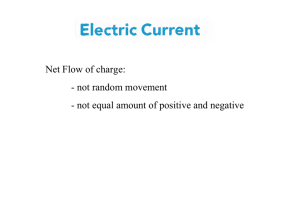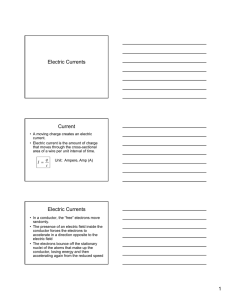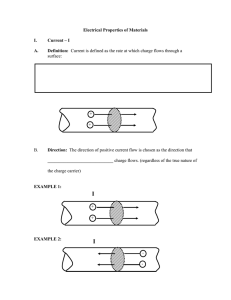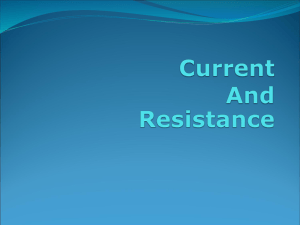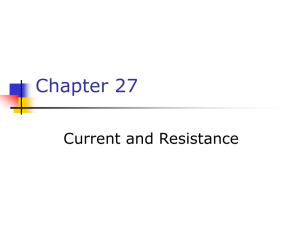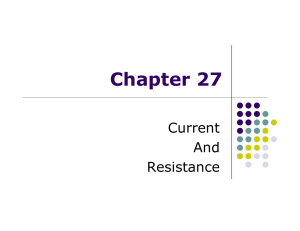P132 Lecture 1
advertisement
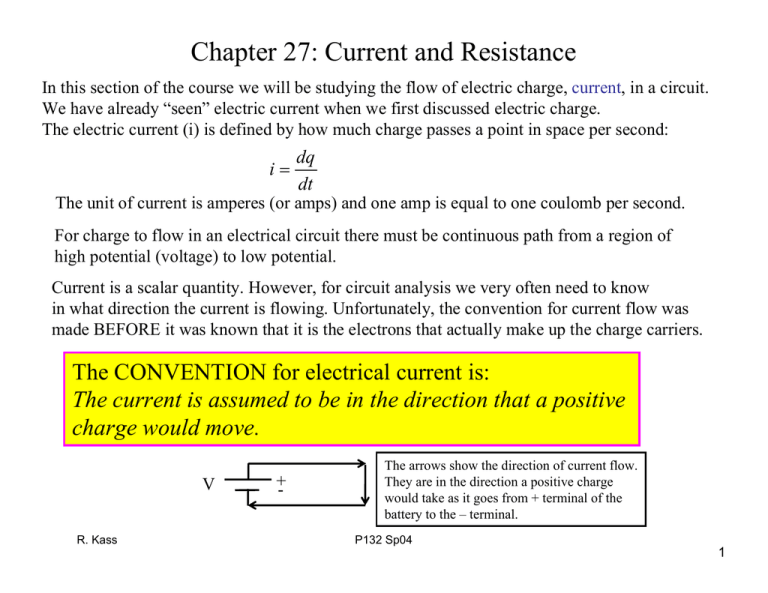
Chapter 27: Current and Resistance In this section of the course we will be studying the flow of electric charge, current, in a circuit. We have already “seen” electric current when we first discussed electric charge. The electric current (i) is defined by how much charge passes a point in space per second: i= dq dt The unit of current is amperes (or amps) and one amp is equal to one coulomb per second. For charge to flow in an electrical circuit there must be continuous path from a region of high potential (voltage) to low potential. Current is a scalar quantity. However, for circuit analysis we very often need to know in what direction the current is flowing. Unfortunately, the convention for current flow was made BEFORE it was known that it is the electrons that actually make up the charge carriers. The CONVENTION for electrical current is: The current is assumed to be in the direction that a positive charge would move. V R. Kass +- The arrows show the direction of current flow. They are in the direction a positive charge would take as it goes from + terminal of the battery to the – terminal. P132 Sp04 1 Electric Current The net motion of charge carriers is responsible for electric current. In an isolated conductor we know that there is no net motion of electric charge. However, there is quite a bit of motion of individual electrons due to their thermal energy. There is no net transfer of charge because the thermal motion is random and as many electrons that move to the left move to the right. We apply an electric field (or a potential) to cause a net transfer of charge. For example, a battery supplies the electric field (or potential difference) necessary for charge to move in an electric circuit. It is interesting to figure out how fast the electrons that are responsible for current move in a conductor. If n = number of charge carriers per volume then the total charge, q, of the carriers in a length of wire L long with cross sectional area A is: q=nLAe (|e|=charge on electron=1.6x10-19C) The carriers are moving with speed vd (called the drift velocity) and the time it takes for the carriers to move a distance L is: t=L/vd q nALe I = = = nAevd We can relate this to the electric current, i, using: I 1 j = The drift velocity is: vd = ( ) A ne ne This can be extended to vector form: j = nevd R. Kass P132 Sp04 t L / vd I/A=“current density”=j 2 Electric Current continued So, how fast do electrons move in typical copper wire? Let’s assume we have 1 amp of current and a copper wire with r=1mm. I 1 j = vd = ( ) A ne ne On page 617 HRW calculates n for copper: n= 8.49x1028 m-3 vd = ( 1A −3 π (10 ) ) 2 1 28 (8.49 × 10 )(1.6 × 10 −19 ) = 2.3 × 10 −5 m / s ~10 cm/hr! The electrons actually drift rather slowly through the conductor. However, the electric field, or changes in the electric field due to motion of the charges moves very close to the speed of light (3x108m/s) and therefore electricity appears to be instantaneous. R. Kass P132 Sp04 3 Resistance and Resistivity We define the quantity called resistance to be: R=dV/dI. The unit of resistance is Ohms (Ω). A very useful electrical circuit element is the resistor. Its universal symbol looks like: We can also talk about a quantity called resistivity, ρ, which is related to the electric field in a conductor and the current density: E = ρJ Instead of resistivity people speak of conductivity: σ=1/ρ. This leads to another relationship: J = σE Finally, we can relate resistivity (ρ) to resistance (R) assuming an isotropic conductor with uniform cross section A: E V /L A =R ρ= = J I/A L resistivity is a property of the material The resistivity of conductors is very small: 10-8 Ω-m (copper, Al) while the resistivity of insulators is very large:1010-1014 Ω-m (glass). If a material has the property that dV/dI is a constant, independent of the magnitude and polarity of V and I (or E) then that material obeys “Ohm’s Law”. obeys Ohm’s law does not obey Ohm’s law Resistors obey Ohm’s law, transistors do not obey ohm’s law! R. Kass P132 Sp04 HRW 27-11 4 Power in Electric Circuits We can calculate how the power in an electric circuit depends on V, I, and R by remembering that the energy (E) to move charge dq through a constant potential difference V is: E=qV => dE=Vdq=VIdt (using I=dq/dt) Power is the rate of energy change or P=dE/dt so we find: P=dE/dt=VI If we want to calculate the power lost in resistor we can use Ohm’s law: V=IR P = IV = I ( IR) = I 2 R V V2 P = IV = ( )V = R R Example: A 2Ω resistor has 5 amps of current going through it how much power will be dissipated in the resistor? P=(2)(5)2=50 Watts (this resistor will be very hot to the touch). Example: A 2Ω resistor has 10 volts across it how much power will be dissipated in the resistor? P=(10)2/(2)=50 Watts R. Kass P132 Sp04 5
